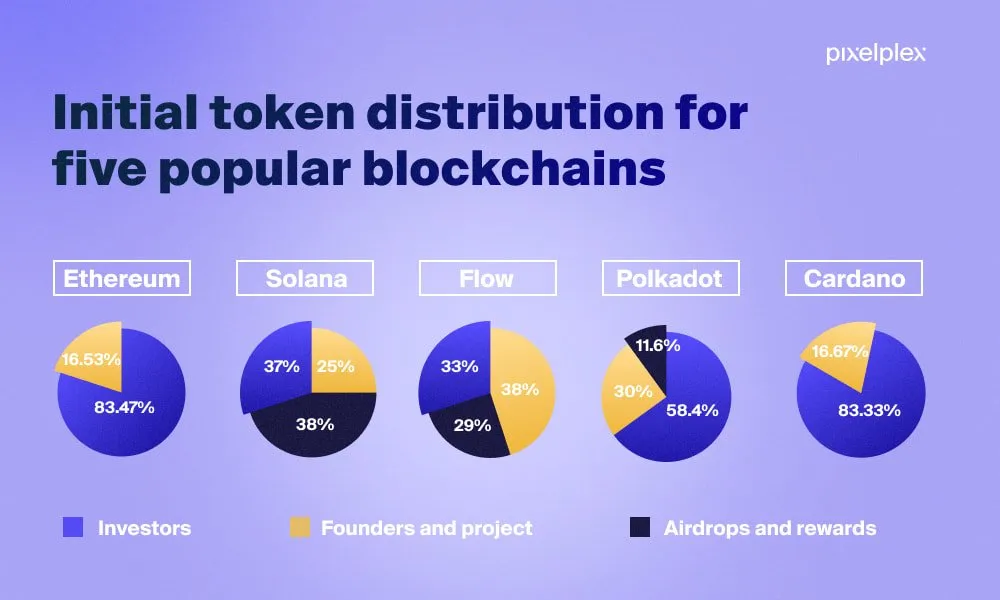Despite their short-term volatility, cryptocurrencies have become increasingly more valuable over time, to the point where any changes made to established projects can generate a lot of controversy, and ultimately fracture the community:
- 2016: Ethereum forks from Ethereum Classic to retrieve funds from a hacker who compromised the $150 million DAO.
- 2017: Bitcoin Cash forks from Bitcoin when the core developers refused to increase the block size.
- 2020: HIVE forks from STEEM to remove the founder's allocation, preventing the owners of SteemIt Inc. from controlling the witnesses.
We should assume that even more important decisions, some involving the real-world, will be made on censorship-resistant blockchains in the future. If that's the case, how can we better resolve our differences, while keeping communities intact?
If effective governance is the key, how can we ensure that community members who have poured their heart and soul into a project are allocated a fair share of the total token supply, and that their vote actually matters in governance decisions?
In this article, we argue that the most important aspect of effective blockchain governance is the fair distribution of rewards to all network participants, and that token allocations should be based on merit.

The Bitcoin Distribution Model
One could argue that Bitcoin has the fairest token distribution model. The founder, Satoshi Nakamoto, did not allocate any coins to himself (otherwise known as a pre-mine) when the network launched back in early 2009.
In order to earn Bitcoin, one had to download the client, join the network, and expend electricity and compute power to validate transactions, otherwise known as mining.
Instead of pre-allocating some Bitcoin for himself, Satoshi mined all of his Bitcoin honestly, alongside all the other participants who volunteered their energy and resources to the experimental project.
The amount of Bitcoin rewards received by the participants was proportional to the amount of resources and efforts they expended.
For example, if you had left your computer running Bitcoin 24/7 throughout all of 2009 and 2010, you would have mined a lot of coins compared to someone who only ran the software for a week.
Unfortunately, earning Bitcoin rewards before more difficult as time went on.
Disadvantages of Bitcoin's Reward Model
In the project's early days, anyone with a spare computer was able to install the Bitcoin software and mine a modest amount of coins. As the network grew, however, the mining difficulty began to increase exponentially, and eventually only investors with significant capital could afford the equipment and energy required to validate Bitcoin transactions.
Unless they joined a centralized mining pool (many of which require KYC now) it was virtually impossible for newcomers to receive rewards for their contributions to the network. For that reason, many Bitcoin miners started to look into alternative cryptocurrency projects.
In more recent years, a lot of innovative blockchain projects have started to offer alternative ways to earn tokens, aside from just mining. For example, writing content, playing games, or deploying real-world physical infrastructure can earn you rewards. In addition, these newer projects usually come with a form of built-in governance.
The Purpose of Governance
Not only can blockchains like Bitcoin keep track of trillions of dollars for us, they can also be used to verify the results of important votes. For example, spending proposals, protocol changes, and network validators can all be voted on by the community using blockchain technology. This allows us to settle disputes transparently and democratically.
For example, if Bitcoin had been engineered with a built-in governance mechanism, the controversial block size debate back in 2017 could have been voted on transparently by the entire community, instead of decided by a small group of core developers (who may have been under the influence of outside interests).
Ultimately, changes to the Bitcoin core protocol are controlled by a small group of people, who approve pull requests on Github and publish new versions of the software for the miners to install. One could argue this choke point has increased Bitcoin's centralization, and made the case for better blockchain governance systems.
Enter Pre-mines
There are other crypto projects that adopted Bitcoin's distribution model. For example, Litecoin, Ravencoin, and Dogecoin neither had a pre-mine, nor a private sale. On the other hand, we have projects like Ethereum that did launch with a pre-mine, allocating about ~16% of the initial token supply to the project's founders.
Pre-mines allocate a portion of the initial token supply to founders, private investors, venture capitalists (VCs), and other insiders. For better or worse, it has become more common for modern crypto projects to come with a pre-mine, with much of it going to project founders and VCs.

This practice, while offering immediate funding to the founders, and an incentive to the investors, poses long-term challenges to a crypto project.
The Dangers Of An Unfair Token Distribution
One obvious problem of an unevenly distributed token supply is potential price manipulation. Whales who have been allocated large chunks of the supply can cause the price of a cryptocurrency to fall suddenly by placing large sell orders.
Thinking further into the future though, when fiat currencies may not be so relevant (due to excessive inflation and the establishment's plan to launch CBDCs) we need to consider how governance could be negatively impacted by a mis-allocation of tokens.
Whales Vs. The Community
Imagine we have a blockchain where 99% of the active community members hold only 10% of the supply. Meanwhile, the founders and VCs own greater than 50% of the supply, with the remaining 40% yet to be distributed.
Firstly, consider how the community will have very little say over which validators are elected to process transactions on the network. This threatens the censorship-resistance of the blockchain, as the validators will essentially be under the control of insiders, who could collude to censor transactions.
Also consider what would happen if the community submits a governance proposal, and then a VC whale with no real affinity to the project comes along to veto it. This possibility discourages small community members from participating, because they know a few whales could easily override their vote.
Leveling The Playing Field
One could argue that VCs have a vested interest in these projects because they have invested large sums of capital into them. However, these days we have many privileged investors (those who got in on the fiat pyramid scheme early) who sit close to the money faucet and have collected handouts from the central banks in the form of ZIRP, QE, and bailouts.
We must consider that, until proven otherwise, these anonymous investors may be only interested in fiat gains, and opposed to a disruptive financial system that serves future generations. At the end of the day, investors and community members alike need to ask themselves if they're in crypto for fiat riches, or financial freedom.
Although these newer crypto projects offer innovative governance mechanisms, and new ways to reward newcomers aside from mining, we need to consider how these pre-mines and large chunks of the supply controlled by insiders could negatively impact governance in the future.
Ultimately, we need a way for new and existing community members alike to be able to contribute to the project and receive rewards proportionate to their efforts, such that their influence isn't overshadowed by investors who have no real affinity to the project.

Combating Whale Votes
Aside from simply not having a pre-mine, and distributing tokens fairly, how can we solve the potential issues that come with a poorly allocated token supply?
Considering that whales often vote with a large chunk of tokens from a single address, we could better gauge how the community feels by adding up the total number of unique addresses that have voted on a proposal, rather than the total number of tokens.
The problem with this solution is that we don't know if a single whale has split their tokens over multiple addresses, making it appear as though 10 different people have voted "yes" on a proposal, when in reality it was a single individual.
We could also require that government-issued IDs be linked to blockchain addresses in order to verify unique wallets. In fact, this is what Block One attempted to do with their Voice social network on EOS, with limited success.
The problem is that matching real-world IDs to blockchain addresses requires a trusted and centralized third-party. Also, doing so would exclude a large portion of the world populace that hasn't been issued government identification.
Linking government IDs to wallets would also create privacy concerns, as all of an individual's transactions would be visible to the public. That said, zero knowledge proofs could be used to verify unique addresses on a blockchain, while still preserving user privacy.
Reputation-Based Voting
Another idea is to weigh blockchain votes based on an account's reputation.
What factors would boost an account's reputation?
- Date of account creation (the earlier, the better)
- Are the account's tokens staked?
- How long have their tokens been staked?
- How often does the account vote on validators?
- How often does the account vote on governance proposals?
- Does the account contribute/curate content (in the case of HIVE)
All of these factors weighed together could give an account more voting power than a whale (token-rich) account which remains relatively inactive.
The Potential For Forks
If you fail to combat the whales, and fail to implement a reputation-based voting system, you will most likely end up with contentious hard forks, a situation where the blockchain splits into two, due to irreconcilable community differences.
In this case, the addresses of the founders and VCs are identified, the community comes together to fork these tokens out of the total supply, and simultaneously transfers the majority of the talent to a new chain.
In fact, this is exactly what happened when HIVE forked from STEEM in 2020. The community came to the conclusion that the founder's 10% allocation was not serving the project's best interests, and completely cut it from the supply.
Telos is another example of a blockchain that was forked from an existing project. The initial token supply of Telos was derived from the EOS initial coin offering (ICO), but with accounts capped to a maximum of 40,000 tokens. This cut out the whales, and made the project more fair and democratic.
In order to avoid these contentious hard forks, and solve our issues via governance, it's crucial to distribute tokens to participants based on merit.
Until next time...
As we enter into the age of transparency, where public discourse is expected to happen on social media, and votes take place on public blockchains, it's critical that the tokens of these projects be distributed fairly. Pre-mines that generate an unfair initial allocation of tokens could come back to bite the community in the future.
Critical issues, like the ones that caused Ethereum, Bitcoin, and STEEM to fork in the past, have made obvious the need for built-in governance mechanisms in blockchain systems. And governance functions optimally when a project's coins are distributed fairly to the community in proportion to each individual's contributions to the network.
Some token mis-allocations may have to be resolved with hard forks in the future. For the time being, you may want to start actively participating in governance/voting, staking, content generation, liquidity providing, etc. on the blockchains that you're interested in, to build a solid reputation for your addresses.
If you learned something new from this article, be sure to check out my other posts on crypto and finance here on the HIVE blockchain. You can also follow me on InLeo for more frequent updates.
Resources
The Sliced Pizza Image [1]
Pixelplex Initial Token Distribution Image [2]
Other Images Courtesy Of Venice AI [3]